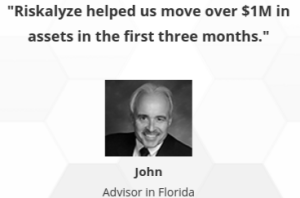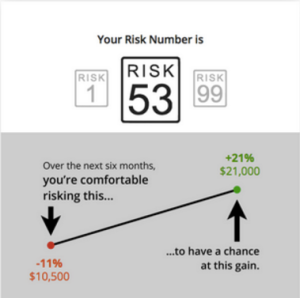Let’s get this out of the way first: this is a post targeted more towards advisors and was inspired partly by a conversation on Twitter. Nerdy terms and opinions will follow. What this ISN’T, is an attempt to offend anyone at Riskalyze, or its users – both groups are trying to do what they think is best for clients (just like I am).
Assessing risk tolerance is an absolutely vital, and legally required, task among RIAs, but how we get there is a point up for debate. Risk tolerance software is all the rage right now, but I’m not sold on its advertised use case. From my view, the software is treated more as a means to generate “sales” and also as a way to check off a compliance need.
My definitions, with regard to all things Risk Tolerance:
Static approach – an advisor will base portfolio decisions based off of a single point (or points) in time after a client answers a risk tolerance questionnaire. In my eyes, the level of customization within a questionnaire doesn’t provide value. It’s still a questionnaire – subject to the whims and wild, short term oscillations of human emotion. A questionnaire taken at 6:01pm today, could be completely different than a survey taken at 6:21pm today, all else equal. An advisor using a static approach to risk tolerance, and its subsequent effect on portfolio management, may be naturally inclined to accommodate with their suggestions and advice according to questionnaire results. Accommodation makes it easier to give clients what they *want* instead of what they *need* and the static approach is advertised as more efficient because it cuts down on the time spent with clients. Cutting corners in the name of more sales today is not a wise way to generate long-term business – in my opinion, of course.
Dynamic approach – an advisor recognizes risk tolerance is amorphous and slippery and can only be assessed over the long-term, through multiple interactions and many different market environments. Assessing long-term risk tolerance doesn’t mean taking the same questionnaire numerous times. A long-term approach to risk tolerance means the advisor is trying to make a best-guess attempt at an ultimately subjective and volatile piece of information (read: not quantifiable as a single point on a 1-99 scale). A dynamic approach to risk tolerance is much harder because it involves educating a client after having numerous conversations in a years-long process and after observing her behavior, instead of accommodating simple questionnaire results. The dynamic approach takes time and has no immediate financial reward to the advisor like a one-and-done risk number might provide. Is there really a tangible difference between a 42 and a 43? The “It’s That Easy!” message just doesn’t resonate for an advisor taking the dynamic approach. At the absolute core of the dynamic approach is a relationship.
My conversation on Twitter started with a comment I made about Riskalyze, a provider of risk tolerance software for advisors. Their CEO, Aaron Klein, got into the mix for some debate. The tweet was shared by Advisor Tech Guru Extraordinaire Bill Winterberg, and he tagged some prominent Riskalyze users. Thanks, Bill? Anyway, my thoughts aren’t meant to be directly critical of anyone’s use of Riskalyze – if they feel it brings value to their clients, that’s fine! – but I’m trying to explain why I don’t use this kind of software and why I used the term “shtick.”
As I told Aaron, I don’t think he and his company have bad intentions. They want to help RIAs succeed. My main point is that I think they try to sell something I view as having dubious merit, and I think they go about it in a strange way. It doesn’t mean using the Riskalyze approach is evil or tries to skirt a fiduciary touch. An RIA using Riskalyze is without a doubt better for a client than using a broker. I’ll try to explain a little more about my personal experience below.
I made the comment that I was “annoyed by their whole shtick” because I went through the process of trying to evaluate their offering and their sales people keep calling/emailing me (*more on that later). While I was kicking the tires about a year ago, the process just rubbed me the wrong way, compounding my doubts about their offering I had in the first place.
I view these testimonials as Broker-speak, but your opinion may vary:
First, they offered no demo environment, no way to actually try the product for a limited time. This is not the norm in the “fintech” RIA vendor world – or at least with the many, many offerings I’ve tried out. Why can’t I try the product out, like the rest of your industry-mates allow? To me this type of policy usually raises a red flag. What if you couldn’t test-drive a car from the dealer before a purchase? Even Tesla does a test-drive. If this has changed, please let me know, Riskalyzers.
Second, the language and sales pitches used, to me, oozed of the short-term focused, sales-metric-touting lexicon of a broker culture versus the more long-term focus RIAs typically desire. I’m completely paraphrasing here, but the sentiment in a demo video was similar to “Advisor Dan increased his close rate to 95% after the first month of using Riskalyze” or “Advisor Sally brought on a million dollar client after showing her Risk Number.” The pictures above are pretty similar. If I view risk tolerance assessment as a subjective undertaking that requires a heavy emphasis on client education and time, then touting a quantitative approach built on “Nobel Prize-winning science” is probably not going to be my thing. (Sometimes Nobel Prize-winning science is best left in the laboratory)
Science is an interesting term to bring up and it probably encapsulates the debate perfectly. Risk tolerance, and its parents Ability and Willingness to take risk, is best viewed as art – not as science. As advisors, one of our biggest tasks (if not the biggest) is minimizing the behavior gap and that involves being knee-deep in the behavioral trenches of investing – an approach I believe is best left for words, time and conversations with the emotional, human being clients involved. Including an Investment Policy Statement, which records and lays out all changes in client willingness and ability to tolerate risk lays the groundwork for “behavior gap: zero.” Risk tolerance is not, in my opinion, a number between 1 and 99.
Quite simply, if I’m on the fence about the use case, I don’t like the way they sell the product, I can’t try the product out in a trial and they use broker-ish and sales-y terminology throughout, then I don’t feel there’s much else I can say to explain my point of view here.
If taking this stance means I have to eschew whatever short-term benefits I may get from using a static assessment approach, or I have to take a contrarian opinion on the subject, then so be it.
Friday edit: you can get your own Riskalyze Risk Number in about 30 seconds, by using one of the links on any number of advisor sites. Just search for “Riskalyze Test.” Is this really the way advisors should be framing investing? It’s not blackjack! The quickest way to having mismatched expectations is to start quoting return numbers, up or down, derived from a short period of time:
*More on my recent contact with the Riskalyze team (some sarcasm may be present):
They reached out to me yesterday with curious timing – it was Fed Day™ – as well as today with an email and a call directly after to follow up. The Riskalyze sales guy was seeing if I wanted to “stress test” any portfolios for a 25bps rise in interest rates. Now, nothing wrong with that on the surface, right? It’s nice to see they’re concerned about my portfolios! That’s so nice of them. But what if I already have suspicions about Riskalyze being more “broker” than “RIA” and what if I already suspect the merits of the services they offer? Then I guess you’d understand how I’d take exception to the offer with even more reason now:
Offering to test one of my portfolios against an interest rate hike on Fed Day is a blatant attempt to play on my Fear of the Unknown because the big, bad Federal Reserve was surely going to cause massive reverberations with its first interest rate hike on Wednesday. Yes, you’re right, Riskalyze, I must indeed test and take action based on short-term market movements, and how did you know I was vulnerable to sales pitches on this emotional day?! If you think I haven’t considered the duration profile of client accounts and if you think you’re notifying me on Fed Day of the “danger” of rising rates, then you are mistaken.
I can plug in a portfolio to Excel, throw in some duration numbers and calculate the effect of any interest rate movement I dream, in about five minutes. Were you thinking advisors didn’t have this ability? Thanks, anyway, guys. RIABiz wrote a great piece about this sort of thing – and I fully agree with Brooke Southall’s sentiment, and I believe it translates perfect to the Riskalyze portfolio stress test offer. An offer to “stress test a portfolio” on Fed Day, because I surely must be a reactive and active-focused advisor who is influenced by daily oscillations, is an insult to my intelligence. Get this stuff out of here, Riskalyze, or direct it to the broker world. This garbage is for the active managers of the industry, for the watch-spinners and for sell-side, CNBC-watching lemmings working in the wirehouses.
Brooke says it far better than I can:
“The group that continues to refuse — deliberately, if not willfully — to get it is those providers of picks and shovels to RIAs — vendors. Either they are selling the wrong product, selling it in the wrong spirit or marketing it in the wrong way.”



